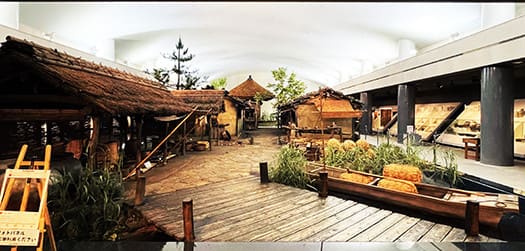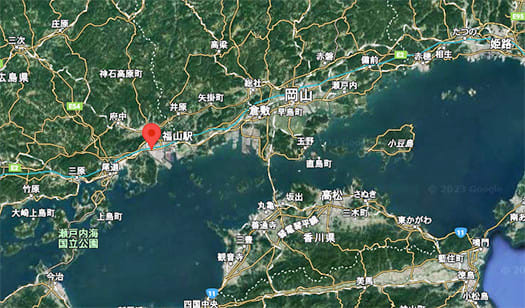


7回にわたって約1000年前ころの札幌の遺跡について探索をして見ましたが、やはり同時並行的に日本史上の遺跡も考えて見たい、ということで広島県東部・福山市の港湾遺跡「草戸千軒」再訪であります。
擦文の遺跡は約1000年前と言うことでしたがこの草戸千軒遺跡も約1000年前時期から4-500年前のころまで栄えていたとされています。ちなみに「千軒」というのは一種の比喩表現でたくさんの建築・住宅、それも商家や職人たちの集積した中世的都市ということ。瀬戸内海交易圏というものは日本史で大動脈的な役割を果たし続けてきた。
わたし自身の家系伝承では同じ瀬戸内海交易圏の姫路近くの「英賀千軒」に深い縁があり、そこが危機に陥ったとき、同族が商家として生き延びていたこちらの草戸千軒〜のちには尾道〜などの交易圏地域に活路を見出したという経緯をたどれる。江戸期には尾道を根拠地として「あがや」という商号で商家を営んでいた。
江戸期にはわが家の直接の家系が尾道から5-6kmで草戸千軒・福山との中間地点の「今津」という宿場町で商家を営んでいた。こちらの菩提寺墓域には直接のご先祖のお墓もある。
ちなみに尾道とこの草戸千軒地域は22-23kmという近距離。瀬戸内海の港としてはお隣り。草戸千軒都市は、現在の福山市内を流れる芦田川の瀬戸内海河口に立地していて、1673年に洪水で都市が流されたという記録があるそうですが、近距離である尾道と連携していた存在だと思います。
日本の商業の発展にとって瀬戸内海はその最大の中核地域。京大阪という日本の最大都市圏への船舶での物流の大動脈地域であり続けてきた。草戸千軒はその中継スポットとして非常に重要な役割を果たしてきた。


尾道は現代にまでつながる商業都市ですが、一方の草戸千軒は「幻の中世都市遺跡」。その遺跡については福山市中心部の城下公園に福山歴史博物館「草戸千軒ミュージアム」として記憶遺産化されているのです。写真は館内の中核的な展示で撮影許諾された原寸大復元遺構であります。
建築・住宅という目線でも非常に興味深い「庶民のくらしぶり」が約1000年近い時間を超えて迫ってくる。綿密な考証によって復元された建築群は強烈なリアリティを放射してくれる。こういった部分では、残念ですが札幌の擦文遺跡とは巨大な径庭がある。
以前にも一度このブログで紹介したのですが、最近ふたたび墓参の機会があって、ふたたびミュージアムを再訪。そこでまたいろいろな「気付き」が得られたので、シリーズで紹介したいと思います。
English version⬇
Seto Inland Sea City Ruins of Kamakura Muromachi Period Kusado-Senken 2023 Revisited-1
A very interesting medieval site both in Japanese history and in terms of genealogical research. We will re-experience the atmosphere of the lifestyle and way of life of a logistics port trading center in the Seto Inland Sea. ...
We have explored the ruins of Sapporo around 1000 years ago seven times, but we also wanted to consider the ruins of Japanese history in parallel, so we revisited the port ruins "Kusado-Senken" in Fukuyama City, eastern Hiroshima Prefecture.
The Kusado-Senken site is said to have flourished from about 1,000 years ago to 4-500 years ago, while the Abraviation site is said to be about 1,000 years old. The "Senken" is a kind of figurative expression for a medieval city with many buildings and residences, including merchant houses and craftsmen. The Seto Inland Sea trading area has continued to play a major arterial role in Japanese history.
In my own family tradition, I have a deep connection to the Eiga Senken family near Himeji, which is also in the Seto Inland Sea trading zone. When that family fell into crisis, I can trace how they found a way to survive in the trading zone, including Kusado-Senken and later Onomichi, where their family had survived as merchant families. During the Edo period, the family operated a trading house under the name "Agaya" with Onomichi as its base of operations.
It is said that during the Edo period, our family directly descended from a merchant family that ran a trading house in an inn town called Imazu, which is 5-6 km from Onomichi and is halfway between Kusado-Senken and Fukuyama. There is also a grave site of his ancestors here.
Incidentally, Onomichi and this Kusado-Senken area are a short distance of 22-23 km. The city of Kusado-Senken was located at the mouth of the Seto Inland Sea on the Ashida River, which flows through present-day Fukuyama City. There is a record that the city was washed away by a flood in 1673, but it seems to have been an existence linked to Onomichi, which was a short distance away.
The Seto Inland Sea area is the largest "cradle" area for the development of commerce in Japan. It has continued to be a major artery region for logistics by ship to the largest metropolitan area in Japan, Kyoto-Osaka. Kusado-Senken has played a very important role as a relay spot.
Onomichi is a commercial city that has been linked to modern times, but Kusado-Senken, on the other hand, is a "phantom medieval city site. The ruins have been memorialized as the Fukuyama Museum of History "Kusado-Senken Museum" in the castle park in the center of Fukuyama City. The photo shows the full-size restored remains that were permitted to be photographed for the museum's core exhibit. The photo shows the "way of life of common people," which is very interesting from the viewpoint of architecture and housing, transcending a period of nearly 1,000 years. The architectural group restored through meticulous research radiates a strong sense of reality. In this respect, unfortunately, there is a huge gap between the Aburibun ruins in Sapporo and the rest of the site.
I have introduced the museum in this blog once before, but recently I had an opportunity to visit the tombs again and revisited the museum again. I would like to introduce the museum in a series of articles, as I have gained various "insights" there.



















